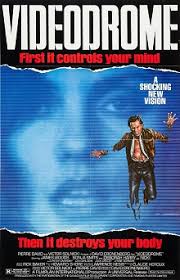
Max Renn (James Woods) is one of the owners of a small TV station located in Toronto called CIVIC-TV. They specialize in smut. The station has an unauthorized satellite dish that picks ups various shows. The underground equipment is run by Harlan (Peter Dvorsky). Harlan shows Max a 53 second transmission about a show called Videodrome. The transmission is a violent torture porn clip from a snuff movie. Always looking for something new, Max wants to know more about the show. Eventually Harlan finds out that the show comes from Pittsburg and begins downloading it for Max.
On a talk show Max meets Nicki Brand (Debbie Harry). Nicki happens to be into S&M. When she sees the Videodrome tape she wants to watch it. She says it will get her excited. They watch the tape. They play a few games. Nicki is very interested in auditioning for the Videodrome show. Nicki goes off to Pittsburg to audition but tells Max that she is going on an assignment for work. Nicki never returns.
Max asks Masha (Lynne Gorman), a promoter of X-rated movies to find out what she can about Videodrome. Masha reports back that the show is not fake. People are actually being tortured and killed on camera. She says the show is part of a political movement that is headed by Brian O’Blivion (Jack Creley). O’Blivion was also on the talk show with Max and Nicki but he was only on videotape.
When Max looks for O’Blivion he finds that his daughter Bianca (Sonja Smits) runs a strange homeless shelter where people watch TV all day long. He finds out that O’Blivion died of a brain tumor caused by Videodrome. O’Blivion may have created Videodrome but it has been taken over by an evil organization that wants to use it for malicious purposes. Now that they have exposed Max to Videodrome they plan on using him to further their cause. Max no longer knows what is real and what are hallucinations from exposure to Videodrome. He begins to spiral out of control.
“Videodrome” was released in 1983 and was directed by David Cronenberg. It is a Canadian science fiction movie in the peculiar sub-genre “Body Horror”. What adds to the body dysmorphic aspects of the film are the makeup effects of Rick Baker. Considered, in some circles, as a conspiracy theorist’s wet dream, the film delves into psychosexual themes and is incredibly surreal. Of course such a cerebral film would invariable tank at the box office. It only survives due to the omnipresent cult base.
I realize that television is influential and some people will believe anything but it comes to a point where what someone believes may not always be the fault of the media they are indulging in but in some random signal problem within a person’s brain synapses.
I will freely admit that after watching the film, I didn’t get it. In looking into it I found out that the basis of it is related to Cronenberg’s childhood. It seems he used to pick up television signals from Buffalo, New York, late at night after Canadian stations had gone off the air. The thought of this worried him. He began thinking that he may see something disturbing not meant for public consumption. Now that I know that the film was developed from Cronenberg’s childhood psyche I feel better about not getting it and I am a little concerned about Cronenberg’s brain’s nerve cells.
David Tsubouchi appears briefly as a Japanese porn dealer. He later became a Minister in the Ontario provincial government. His appearance in the film as a pornographer was exploited by his opposition.
Cronenberg had to double for Woods in the scene were Max Renn has a Videodrome helmet put on his head. Woods was afraid of getting electrocuted.
Rick Baker and his crew did the special effects. To create the breathing effects of the television set that Max interacts with, Frank C. Carere utilized an air compressor with valves hooked to a piano keyboard. The undulating screen of the television set was created using a video projector and a sheet of rubbery dental dam. Baker stated "I knew we would need a flexible material ... we tested with a weather balloon first, stretching it over a frame the size of a TV screen, and pushed a hand through it to see how far it stretched, and then we rear-projected on it." The videotape cassettes inserted in Max’s stomach slit were Betamax. VHS tapes were too big to fit. Baker's original concept for Max's flesh gun featured eyes, mouth and foreskin. Cronenberg thought it to be "too graphic".

